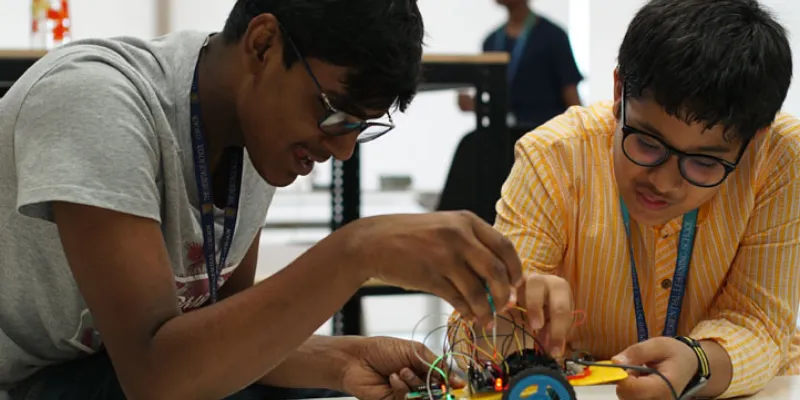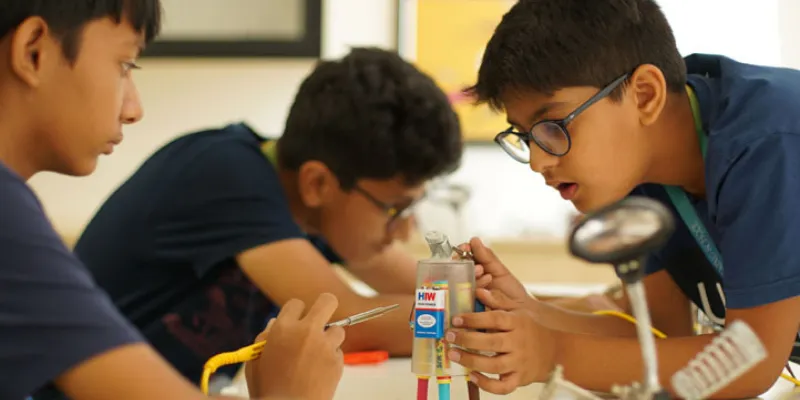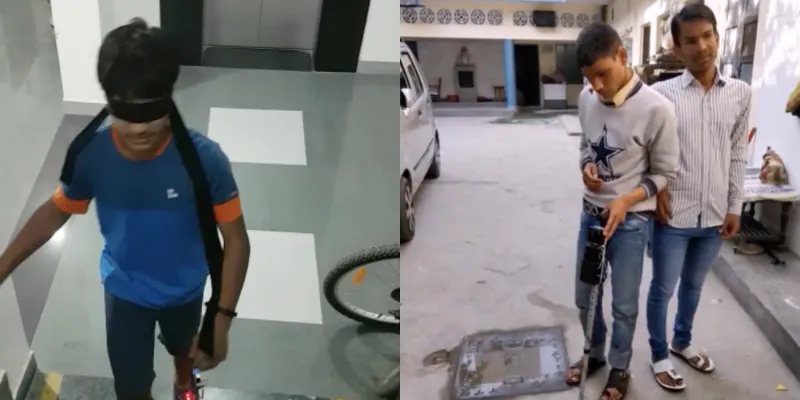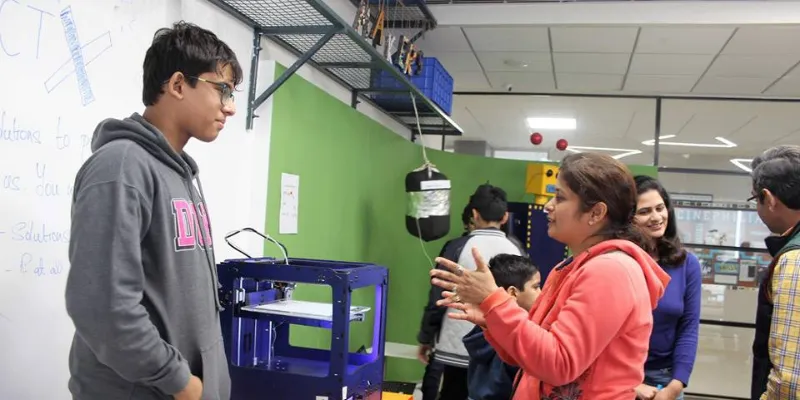Makerspaces in schools: Gurgaon students develop smart devices to enable visually impaired
Students of Gurgaon’s Heritage Xperiential Learning School, known for its project-based learning approach, have developed devices like an automated walking stick, 3D printed braille cards, and “help me” shoes for the visually impaired.
Marks and grades may still be the norm in many schools across India, but some schools are doing things differently. At Heritage Xperiential Learning School in Gurgaon, students are encouraged to develop their design and lateral thinking skills, and create devices that can bring about societal change.

Students of Heritage Xperiential Learning School working on one of the devices.
No wonder then that a group of six students belonging to classes 9, 10 and 11 have built smart devices that can better lives around them. The students have, under the Saksham Project, a part of the school’s pedagogical Maker-centred learning programme, successfully designed and developed devices such as an automated walking stick, 3D printed braille cards, and “help me” shoes. The project was introduced in 2016 to enable students to use digital tools to address issues of social relevance.
The fact that over 10 lakh people in India – one percent of the entire population - are visually impaired (according to the 2001 Census) led the students to focus on them.
The devices designed by them can help the visually impaired go about their daily tasks easily, and handle some of the challenges they face: walking through different places and finding reading material in accessible formats. The students took three years to conceptualise, design, and develop these smart devices.

The Heritage Xperiential Learning School campus in Gurgaon.
“These products created by students of Heritage School are helping me lead an independent life. I use the automated walking stick whenever I go around my college campus or when I go to a mall. It helps me to move about without bumping into things. I don’t have to worry about preparing for exams as they have converted textbook content into braille cards and audio files,” says Himanshu of Bharat Blind Technical Welfare Society.
Project Saksham: developing working prototypes
To understand some of the common issues that visually impaired students face with regard to mobility, education, and social stigma, the students interacted with visually impaired people at Bharat Blind Technical Welfare Society, Delhi, and Captain Chandan Lal Special Middle School for Blind, Gurgaon.

Students working as part of the makerspace curriculum at school.
Jivitesh Singh Kamboj, a student of Class 12 at Heritage Xperiential Learning School told YourStory,
“After brainstorming, we spent time conducting research about the resources and technology required to build devices that can aid the visually challenged. After three years of groundwork, we developed working prototypes of some products under the Saksham Project."
The automated walking stick, one of their trademark devices, works as a proximity detector. The stick alerts the visually impaired to all obstructions in their path, reducing accidents. These alerts are produced using a buzzer, which uses vibrations rather than sound to enable better responses from the user.
The students used a combination of Arduino, an open-source electronics platform as well as a few artificial intelligence tools to read inputs like light on a sensor, finger on a button, and hurdles along the way. The stick is also embedded with ultrasonic sensors that can determine the distance of objects from the user during movement.

Visually impaired using the automated walking stick developed by the school students.
The students also developed a pair of shoes that can help the visually impaired detect danger. The underlying mechanism of the “Help Me” shoes is similar to that of the walking stick, except for an added feature that sends an automatic message to the police in case the user faces an emergency situation. The user needs to tap the shoes repeatedly on the ground thrice to trigger the message.
“After realising that the visually impaired do not have access to educational resources in appropriate formats, we designed 3D printed braille cards with the assistance of school faculty. For instance, we produced braille content about the phases of the moon and shapes of animals so that they could learn these concepts through touch,” Jivitesh says.

Students working on the prototype of the "Help Me" shoes (left) and shoes at display during the testing phase.
Four to five working prototypes of all these devices, including the walking stick and braille cards, were given away to the blind schools free of cost. All the expenses incurred to make the devices was born by the administration of Heritage Xperiential Learning School themselves. The school is currently in talks with a few companies to replicate the designs of these devices and manufacture them to be sold in the market.
Kabeer Kishore, a student of Class 12, says,
“The first time I visited the blind school, I saw a visually impaired person struggling to make his way down the stairs, without any aid. This motivated me to work towards using technology to develop devices that can help them lead their daily life without hassle. Since then, the journey has been enriching. The smile on their faces after we gave them these devices is something to be cherished forever."

Students of Heritage Xperiential Learning School interacting with the visually impaired at a blind school.
From digital consumers to digital creators
Apart from these devices, students of Heritage Xperiential Learning School have designed many other tools that incorporate the latest technological trends. This has been made possible by adopting a comprehensive digital literacy curriculum called Maker-centred learning. This curriculum, for students of Class 4 to 12, includes subjects like data science, artificial intelligence, coding, and machine learning.

Teachers giving feedback to the students during one of the sessions.
The school has set aside time for students from Class 4-7 to learn basic concepts like loops, sequence, and algorithmic thinking through fun activities. The curriculum also includes a weekly programme that encourages students to identify real-world problems and attempt to solve them using the power of technology. The programme includes Genius hours for junior and middle school students and the Build your Future elective for students in senior classes.
Students of Classes 8-12 are given ample time – one year - to work on research, development, and production of prototypes.
Noora Noushad, Head of Design and Technology, Xperiential Learning Systems, says,
“Our school has integrated the concepts of design thinking and digital literacy into the curriculum itself. These interventions are aimed at empowering students to develop the confidence to envision the world differently, and believe that they are capable of championing change through technology.”
Also read: Visually impaired chess player Darpan Inani shows his opponents he is no pawn to be shuffled around






